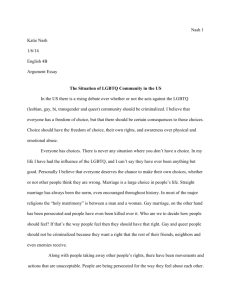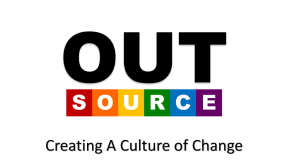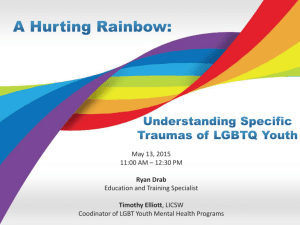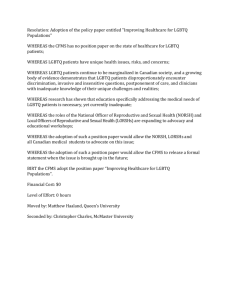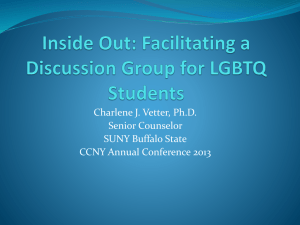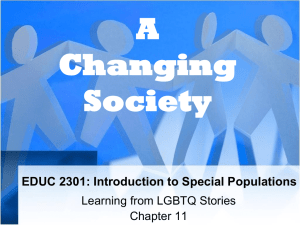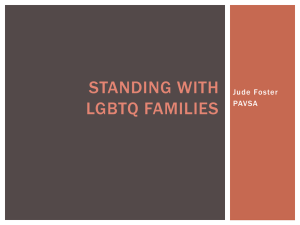School Climate: #ConnectTheDots Brief Safe and Supportive Schools for LGBTQ+ Students
advertisement
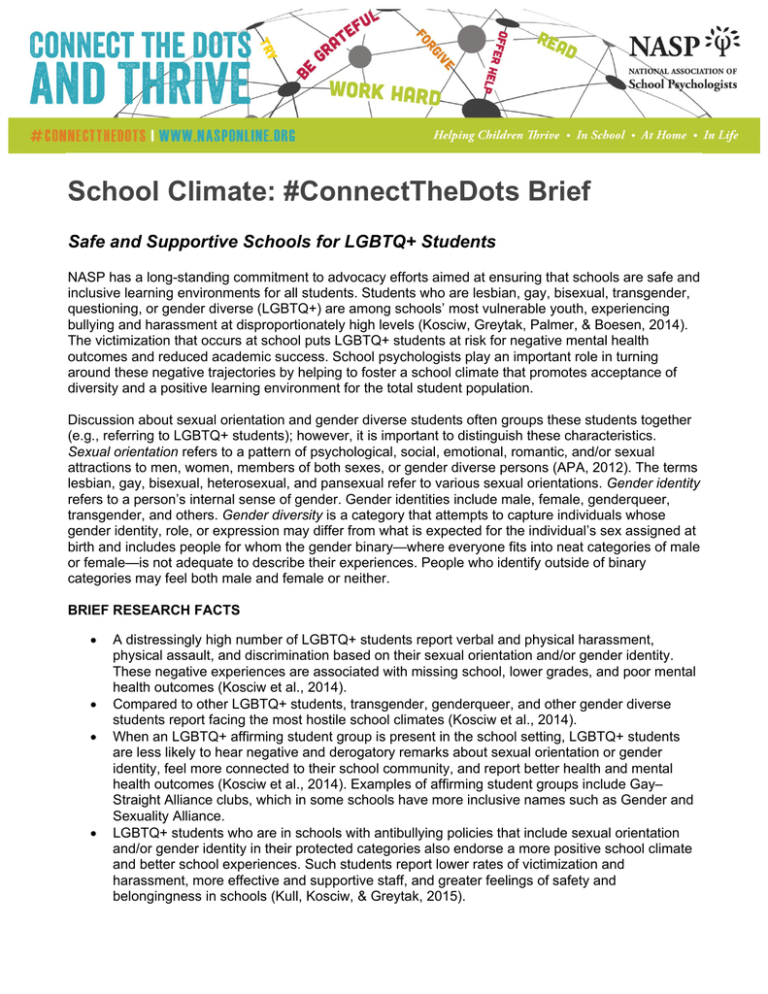
School Climate: #ConnectTheDots Brief Safe and Supportive Schools for LGBTQ+ Students NASP has a long-standing commitment to advocacy efforts aimed at ensuring that schools are safe and inclusive learning environments for all students. Students who are lesbian, gay, bisexual, transgender, questioning, or gender diverse (LGBTQ+) are among schools’ most vulnerable youth, experiencing bullying and harassment at disproportionately high levels (Kosciw, Greytak, Palmer, & Boesen, 2014). The victimization that occurs at school puts LGBTQ+ students at risk for negative mental health outcomes and reduced academic success. School psychologists play an important role in turning around these negative trajectories by helping to foster a school climate that promotes acceptance of diversity and a positive learning environment for the total student population. Discussion about sexual orientation and gender diverse students often groups these students together (e.g., referring to LGBTQ+ students); however, it is important to distinguish these characteristics. Sexual orientation refers to a pattern of psychological, social, emotional, romantic, and/or sexual attractions to men, women, members of both sexes, or gender diverse persons (APA, 2012). The terms lesbian, gay, bisexual, heterosexual, and pansexual refer to various sexual orientations. Gender identity refers to a person’s internal sense of gender. Gender identities include male, female, genderqueer, transgender, and others. Gender diversity is a category that attempts to capture individuals whose gender identity, role, or expression may differ from what is expected for the individual’s sex assigned at birth and includes people for whom the gender binary—where everyone fits into neat categories of male or female—is not adequate to describe their experiences. People who identify outside of binary categories may feel both male and female or neither. BRIEF RESEARCH FACTS A distressingly high number of LGBTQ+ students report verbal and physical harassment, physical assault, and discrimination based on their sexual orientation and/or gender identity. These negative experiences are associated with missing school, lower grades, and poor mental health outcomes (Kosciw et al., 2014). Compared to other LGBTQ+ students, transgender, genderqueer, and other gender diverse students report facing the most hostile school climates (Kosciw et al., 2014). When an LGBTQ+ affirming student group is present in the school setting, LGBTQ+ students are less likely to hear negative and derogatory remarks about sexual orientation or gender identity, feel more connected to their school community, and report better health and mental health outcomes (Kosciw et al., 2014). Examples of affirming student groups include Gay– Straight Alliance clubs, which in some schools have more inclusive names such as Gender and Sexuality Alliance. LGBTQ+ students who are in schools with antibullying policies that include sexual orientation and/or gender identity in their protected categories also endorse a more positive school climate and better school experiences. Such students report lower rates of victimization and harassment, more effective and supportive staff, and greater feelings of safety and belongingness in schools (Kull, Kosciw, & Greytak, 2015). WHAT CAN BE DONE TO MAKE SCHOOLS SAFER AND MORE WELCOMING There are a number of strategies which can be used to enhance school climate and make schools safer and more welcoming to LGBTQ+ students. These include establishing school policies that address bullying, harassment, and assaults and that enumerate LGBTQ+ students among protected groups; offering supportive student clubs; ensuring that curricula are inclusive; providing professional development and parent education related to the needs of LGBTQ+ youth; and making sure every student has access to supportive school personnel (Kosciw et al., 2014). Specifically, school personnel can the take following actions: Stop hate speech. Develop a personal plan to speak out if you hear a student using words like “fag,” “dyke,” “gay,” or “tranny,” amongst others, as put-downs or insults. Ask your administrator for the opportunity to attend trainings on diversity and LGBTQ+ issues. Participate in educators’ conferences that address the needs of LGBTQ+ youth, and speak to current and future educational staff about being allies for LGBTQ+ staff and students. Post safe-space posters (http://www.nasponline.org/resources-andpublications/resources/diversity/LGBTQ-youth/LGBTQ-posters) and materials. Support gay–straight alliances and help LGBTQ+ students and staff advocate for fair school policies. Reach out to both families and students to help make them aware that peers may be struggling with sexual orientation or gender identity. Meet with teachers and families to help them understand about the issues that their students, children, or their children’s peers may be facing as LGBTQ+ persons. Partner with community agencies that offer support services for LGBTQ+ youth and their families. Bring in allied organizations (e.g., PFLAG, https://community.pflag.org/) to educate staff and families on the needs of LGBTQ+ youth. Make sure your library, school healthcare workers, and health teachers include accurate information about gender identity, LGBTQ+ sexuality, and health. Let students know that your office is open to them, should they need support speaking about bullying, violence, harassment, or conflict at home. THE ROLE OF THE SCHOOL PSYCHOLOGIST School psychologists have an ethical obligation to promote the healthy development of LGBTQ+ students and to create a safe and welcoming school environment for all students (NASP, 2011, 2014). School psychologists are equipped to advocate for comprehensive antibullying policies, effective bullying prevention and intervention procedures, and professional development on LGBTQ+ issues for students and school staff. They can support LGBTQ+ students by assisting in forming and advising student groups, referring perpetrators of harassment to administration, intervening after witnessing any type of bullying, and providing affirmative counseling to victims of anti-LGBTQ bullying and students struggling with their sexual orientation or gender identity. RESOURCES LGBTQ+ Youth, NASP Resources: http://www.nasponline.org/resources-andpublications/resources/diversity/LGBTQ-youth American Psychological Association, Safe and Supportive Schools Project: LGBT Youth Resources: http://www.apa.org/pi/lgbt/programs/safe-supportive/lgbt/default.aspx Gay, Lesbian and Straight Education Network, http://www.glsen.org Gender Spectrum, https://www.genderspectrum.org The Trevor Project, http://www.thetrevorproject.org Cowan, K. C., & Klotz, M. B. (2012). Communication Matters: Tips for Building Commitment to Create Safe, Supportive Schools for LGBTQ Students Communiqué, 40(8). Retrieved from http://www.nasponline.org/publications/periodicals/communique/issues/volume-40-issue-8/tips-forbuilding-commitment-to-create-safe-supportive-schools-for-lgbtq-students REFERENCES American Psychological Association. (2012). Guidelines for psychological practice with lesbian, gay, and bisexual clients. American Psychologist, 67(1), 10–42. Kosciw, J. G., Greytak, E. A., Palmer, N. A., & Boesen, M. J. (2014). The 2013 National School Climate Survey: The experiences of lesbian, gay, bisexual and transgender youth in our nation’s schools. New York, NY: GLSEN. Kull, R. M., Kosciw, J. G., & Greytak, E. A. (2015). From Statehouse to Schoolhouse: Anti-Bullying Policy Efforts in U.S. States and School Districts. New York, NY: GLSEN. National Association of School Psychologists. (2011). Lesbian, gay, bisexual, transgender, and questioning (LGBTQ) youth [Position Statement]. Bethesda, MD: Author. Retrieved from http://www.nasponline.org/position-statements/LGBTQ-youth National Association of School Psychologists. (2014). Safe schools for transgender and gender diverse students [Position statement]. Bethesda, MD: Author. Retrieved from http://www.nasponline.org/position-statements/Transgender-students Share How You #ConnectTheDots Help spread the word about the importance of and effective ways to create school climates in which all students THRIVE. Use #ConnectTheDots @nasponline on Twitter, Facebook, and Instagram to share your story. © 2016, National Association of School Psychologists, 4340 East West Highway, Suite 402, Bethesda, MD 20814, 301-657-0270, fax 301-657-0275, www.nasponline.org
